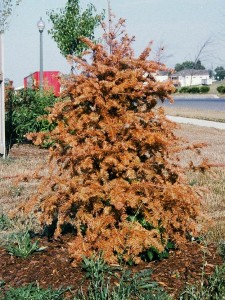Overheated Landscapes
August 9th, 2010
This unrelenting, brutally hot growing season is causing all kinds of havoc for people, plants and water bills. It looks like we’re not done yet.

Heat alone can kill plants that prefer cooler climates, even firs and spruce when we get into Dallas temperatures.
I don’t know about you, but I’ve switched from keep-it-nice mode to survival in my landscape. I’ve got a well and don’t want to run it dry. So I’m only going to spot-water plants I really don’t want to lose from here on out.
A lot of the damage we’re seeing isn’t just from lack of water. It’s from the flat-out ridiculously high day-after-day temperatures. When temperatures approach 100 degrees, pollen dies, fruits and fruiting veggies stop yielding, growth slows to a crawl and some cool-preferring species simply croak.
Pansies and lobelia are two annuals that typically fry in our normal summers, but this year I’m seeing even fir trees browning in the heat. I’ve got several birds nest spruce that have been in the ground for a dozen years, and they’re even turning to toast.
Lots of vegetable gardeners have been asking me about poor bean, squash and tomato yields. The heat fries the pollen, and without pollination, the flowers fall off. The sorry state of our bee population doesn’t help either.
Watering helps only marginally and temporarily when it’s really intense heat doing the damage.
High temperatures increase a plant’s water needs, so when rain isn’t happening, the two conspire to kill that much faster. Watering with a hose, watering can and even sprinklers just doesn’t do the thorough moistening job of a good, soaking rain.
What we really need from here on out is for the temperatures to go back down to at least the mid-80s and for a daylong soaking rain.
Some areas have been getting quick dumpings here and there. Other areas (like my yard) have missed them all, except for that one storm that dropped 3 inches of rain in a few hours. While that’s better than nothing, heavy downpours don’t help gardens much because so much of the rain runs off. Three inches of rain that comes one inch at a time over three weeks is infinitely more helpful than 3 inches in 2 hours.
So I’m going to focus first on trees and shrubs that have been planted in the last three years. Those are the most expensive, long-term investments and are more likely to suffer because their roots haven’t fully established. One deep soaking a week should salvage them.
Scout your landscape, and if you see any deciduous trees or shrubs wilting, losing color, browning at the tips or edges, turning color already and/or shedding leaves, you should have watered yesterday. (Note that some plants, especially hydrangeas, wilt from heat even when the soil moisture is OK.)
Needled evergreens often give you no warning. They just turn brown seemingly all of sudden. When that happens, they’re already dead.
The second focus for me is going to be new and less drought-tolerant perennials that are showing signs of stress. I don’t want to lose those either.
Next is the vegetable garden. If I have to choose between water for a tomato plant or a petunia plant, I’ll go with the tomato.
I’m trying to keep my pots watered with recycled water from the kitchen sink. I usually use water from the rain barrel, but that’s been empty for weeks.
A good bit of my landscape is doing fine since I’ve picked durable and drought-tolerant species in the first place. I haven’t given any water, for example, to my ‘Knock Out’ roses, ornamental grasses, liriope, ninebarks, coneflowers, dwarf lilacs, hollies, Virginia sweetspires, catmint, barrenwort, spirea and amsonia, to name a few.
In-ground annuals are on my sacrifice list. I’d rather not see them die in August, but if something has to give, the rationale is that these will die come frost anyway.
At the bottom of the list is the lawn. Mine has been patchy-brown for weeks (like most people’s). Lawns just take too much water to keep green in dry weather, so I don’t even try. I’ll see what comes back in fall and just reseed/overseed what doesn’t.
At least grass seed is a lot cheaper than replacing a fringetree.







